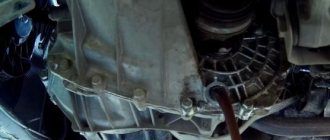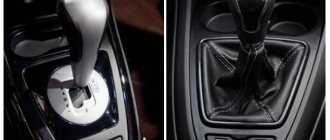Robot or CVT
Which is better, a robot or a variator on the Vesta - you can answer this question by studying the reviews of the owners. Drivers who were able to compare both types of transmissions share their impressions on websites dedicated to domestic cars.
Start of movement
In the latest releases of Lada Vesta with AMT, the designers have provided a “crawling” mode. When the brake pedal was released, the car began to move slowly at idle speed. This feature causes complaints from drivers. There is a delay, acceleration is uneven, twitching is felt. After some time, the speed increases, and in city traffic jams you have to slow down.
On a slippery road. Photo source: ac-ladaufa.ru
Against the background of such robot actions, the variator has an advantage. Acceleration is smooth, no jolts or twitches. Rolling and climbing are similar to a full-fledged automatic transmission. When parking, the car behaves more confidently.
Noisiness
The noise in the cabin of a car with a robotic gearbox is stronger than with a CVT. The hum in the AMT becomes audible even at low speeds. When picking up speed, the advantage of the variator is more obvious.
Vibration
An engine equipped with an AMT vibrates noticeably more than a power unit with a CVT. When compared with an automatic transmission, you get the feeling that a car with a robotic gearbox has a “floating” speed.
Gaining speed and dynamics
Vesta with a robotic gearbox picks up speed better than with a CVT only when engaging third gear. The first two are short, the driver does not have time to feel the acceleration. On the fourth, the advantage with the CVT is noticeable. Plus AMT is a direct connection between the gas pedal and the engine. However, the number of gears is small and switching takes a long time.
Vesta automatic. Photo source: va-online.ru
The CVT has a long response to pressing the gas pedal, and acceleration is slow. After gaining speed, the car becomes more dynamic, and traction failures are not felt. Acceleration after 80 km/h is significantly better than that of the robot; the advantage is felt when overtaking on the highway.
Fuel consumption
Vesta with a CVT is more economical than with a robotic gearbox. The average fuel consumption of the AMT is higher, the difference is 2 liters per 100 kilometers. With gasoline prices constantly rising, this is an advantage of the CVT, even at its higher price.
Many owners who took a test drive made a positive decision whether to buy a Lada Vesta with a CVT.
CVT on Lada Vesta
Some buyers do not know what kind of variator they put on the Vesta. The new modification of the car received a continuously variable variator in the Vesta Jatco JF015E.
CVT Jatco JF015E. Photo source: akppwiki.ru
Paired with this transmission option, the car is equipped with a 1.6-liter engine with a power of 113 l/s. This power unit is installed on alliance models such as Arcana, Captur, Logan, Sandero. Factory engine classification is H4M.
The variator can be installed on all Vesta models, except for the basic version. When choosing a Jatco JF015E box, the buyer does not need to pay for additional functions. This distinguishes the Vesta AT modification from its competitors.
Transmission Jatco JF015E
The Jatco company, part of the Nissan group, released a new CVT model in 2010, which received the full designation Jatco JF015E. Before installing this box on AvtoVAZ cars, engineers improved and finalized the transmission.
Device
The V-belt mechanism is the main part of the box. The elements of the device are cone pulleys and a pushing belt, which transmits torque that changes as the pulleys move closer and further apart. The box also includes a hydraulic unit and a two-stage planetary gearbox, which reduces the weight of the structure and increases the range of gear ratios.
Resource Jatco JF015E
The use of planetary gears in transmissions for small-volume engines makes the design smaller and more compact, but impairs reliability and reduces the overall service life of the unit. The planned service life of the transmissions is 120 thousand kilometers. In practice, box failure occurs earlier. Repair requires special equipment and skilled technicians.
Positive sides
The modified version of the new transmission has advantages:
- the variator has become more compact, it is better located in the perimeter of the subframe, due to which the ground clearance has decreased;
- the load mode is lightened when switching from forward to reverse gear, they shift clearly and smoothly;
- the load when mixing transmission oil has decreased, which is important at low temperatures;
- The functioning of the box cooling system has been improved, it is brought into the same circuit with the engine;
- the acceleration of the car is smooth, without jerks or dips in traction.
Vesta with automatic transmission. Photo source: news.myseldon.com
The developers of the modified Jatco JF015E transmission assure that oil is filled for the entire service life of the automatic transmission. Replacement will only be required during repairs. Although in fact it is better to change it after 100 thousand km, which can significantly increase the service life of the box. But this needs to be done in a workshop.
Minuses
The operating instructions indicate the disadvantages of a CVT transmission that the car driver should pay attention to:
- manufacturers do not recommend sudden starts, slipping and sudden braking - these factors lead to premature wear of the transmission;
- It is prohibited to tow the car for an emergency engine start;
- It is not recommended to use a trailer, as this increases the load on the variator.
Following the instructions, you must treat the variator with care and avoid an aggressive driving style. By following the recommendations, you can avoid the costs of premature box repairs.
CVT problems
Cars with a CVT arrived at dealers in November 2021. Since the summer, the Jatco gearbox has been installed on the XRAY Cross, during which time the operation of the cars revealed problems with the transmission.
Oil quality
The transmission is demanding on the quality of ATF fluid. If you use oil of a class lower than NS-3, recommended by the manufacturer, the variator valve body may fail.
At every vehicle maintenance, it is recommended to check the condition of the lubricant in the box.
Bearing failure
Before the modernization, there were many complaints about the adjustment of the input shaft roller bearing during assembly. The axial play gap was set incorrectly. When pinched, the hub was destroyed, which led to failure of the entire gearbox. Engineers corrected the defect, the unit became reliable, but repairs require fine tuning.
Sun gear failure
This structural element cannot withstand maximum loads and becomes unusable. The gear is welded from two parts; when the car is working hard, the seam does not hold up, the part breaks, and the entire assembly fails. A symptom of a breakdown is the absence of reverse gear when the corresponding position of the shift knob is turned on. Another sign is that the car does not move forward.
Oil pump failure
The valve in this unit fails; it hangs due to oil contaminated with wear products. The lubricant pressure in the variator drops. As a result, the driver feels jolts or jerks when moving from a standstill.
New technologies in domestic production
Buyers choosing a new car look thoughtfully at the new AMT from Lada. What is it, what is its operating principle? In fact, this is a regular manual transmission, only it does not have a clutch pedal. Instead of three levers, you only get two - gas and brake. The compact gearbox has off, on and shift modes, which replace the familiar pedal.
Reviews of the Lada Vesta robot show that not everyone liked the manufacturer’s innovations. The automated gearbox is developed on the basis of the manual transmission of VAZ cars. The control system uses the latest ZF developments, which help to change gears faster.
- Auto mode – allows you not to think about changing gears at all.
- Neutral position is acceptable when the car is parked.
- Reverse – in this position, as you might guess, the car will go backwards.
- Manual shift - allows you to change gears yourself if you want to overtake someone or save fuel. If you want to downshift, then you don’t have to touch the lever at all - the Lada itself will do everything for you if you take your foot off the gas pedal.
Operating rules
The driver is informed in the operating instructions about how the variator works on the Vesta. The control knob has the following switches:
- P – parking;
- R – back;
- N – neutral position;
- D – forward;
- M “+” and “–” – manual switching of a lower or higher gear.
Control knob on Vesta. Photo source: akppwiki.ru
The engine is started in position P. The brake pedal is pressed, and when the lock button is pressed, the handle is moved to D or R, depending on where the movement will be directed.
The gear shift lines are indicated on the handle:
- From P to neutral position N, forward – D, backward – R.
- In manual mode M, downshifts or upshifts are selected.
Mode M is activated only when moving from position D. You can move in reverse only by moving the handle to R from N. The engaged gear is displayed on the dashboard screen.
The rules prohibit moving the lever to the parking position P while driving. This action can lead to damage to the gearbox. When stopping briefly at a traffic light or in another similar situation, P and N are not activated and the vehicle is held down with the brake pedal.
To extend the service life of the transmission and avoid costly repairs, you should follow the rules prescribed in the instructions:
- before starting to drive, especially in winter, let the engine idle for a few minutes;
- immediately after starting to move, rapid acceleration is not recommended;
- the driver must avoid slipping, sudden starts and sudden braking;
- It is prohibited to tow the vehicle to start the engine.
Until the vehicle reaches a mileage of 2 thousand kilometers, towing other vehicles and trailers is prohibited.
Service life of AMT according to instructions and actual
The AvtoVAZ manufacturer indicates a warranty life of an automatic transmission of 75,000 km or 5 years.
In general, AMT takes care of the designated resource, but already in the first ten it is necessary to carry out small works:
- replacing the clutch disc;
- flashing of the electronic control unit;
- tightening the pressure bearing;
- replacing the sealing gland on the AMT.
The presence of a robotic version of the gearbox on the Lada Vesta was greeted positively by many car enthusiasts.
Although breakdowns do occur, they are not critical; in some cases they can be prevented by careful driving and timely maintenance. The final decision rests with the owner of the technical device.
How to use the new gearbox? Reviews from owners of the Lada Vesta 1.8 robot indicate that you still need to learn how to use the AMT. The car's on-board computer displays information that helps monitor the operation of the transmission:
- Mode (manual/automatic).
- Active transmission.
- Brake pedal activity.
So how do you start a Lada Vesta with AMT? To do this you need to follow a number of simple steps:
- Press the brake pedal.
- Move the shift lever to the neutral position.
- Start the car.
Another useful feature of LADA with AMT is that it can be started from a pusher. Rope launch is activated at speeds of 7 km/h and above. The car also has a transmission brake function. When rolling down an inclined surface, it is permissible to use the brake pedal for more effective braking. All these useful modes make operating the Lada Vesta with AMT convenient and comfortable.
Possibility of replacing the CVT with a manual transmission
When using Vesta with a CVT, some owners have problems with the convenience of driving the car. In this situation, the question arises: is it possible to replace the gearbox with a manual transmission?
If the variator breaks down, repairing it or purchasing a new Jatco JF015E transmission will require significant financial costs. The cost of a new variator is 185 thousand rubles, a new manual transmission is 50. In this case, replacing it with a manual transmission seems more economical.
Replacing a CVT is an expensive proposition. Photo source: drive2.ru
On websites dedicated to AvtoVAZ cars, this issue has been repeatedly raised on forums. After analyzing articles, reviews, and user messages, we can come to the conclusion that replacing a CVT with a manual transmission is possible. However, there are opinions that prove the inappropriateness of this work:
- The manual transmission and the cost of replacing the transmission can be comparable to the price of a new CVT with installation;
- Abnormal modifications can significantly degrade the performance of the vehicle's electronic system.
The most reasonable way out of the situation is to sell the Vesta with a repaired variator and purchase a car with a manual transmission.
What configuration does the AMT come with?
Lada Vesta with an automated manual transmission is available only in luxury configuration. When purchasing this assembly, you can also purchase a manual transmission, which is standard. But for the robot you will have to pay about 25,000 rubles.
Considering that the price for a Lada Vesta in the maximum configuration exceeds 600 thousand, a reasonable question arises: is the game worth the candle? What advantages and disadvantages can be found in such a supplement?











